目录
- vue+echarts绘制一个支持切换的折线图
- 使用echarts实现折线图问题
vue+echarts绘制一个支持切换的折线图
在项目中做了一个基础的折线图效果,样式如下
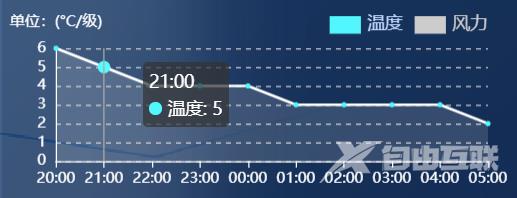
接下来主要记录在项目中echarts的使用流程
主要关注《xxx》中的内容,其余部分依项目不同而变化
- 折线图如何添加阴影
- 折线图如何进行线段切换
- 折线图如何进行动态数据绑定
- 折线能够从0开始显示,两端不留空白
- echarts在项目中的使用流程
// 页面初始天气数据的获取
getWeatherNew(eeiId) {
var option = {};
let _this = this;
《==注意内外数据的this指向问题 下面有四个变量this指向作用域外,需要提前记录外部this==》
api.getWeatherNew(eeiId).then((res) => {
this.weatherData = res.data.hourlyDTOList;
// 天气状态加载
_this.weatherSpan.text = this.weatherData[0].text;
_this.weatherSpan.temp = this.weatherData[0].temp;
_this.weatherSpan.windDir = this.weatherData[0].windDir;
_this.weatherSpan.windScale = this.weatherData[0].windScale;
option = {
legend: {
icon: "rect",
data: ["温度", "风力"],
《==这里data对应下面的series中的name,name不同对应不同的折线效果==》
textStyle: {
//文字样式
color: "#c1dafc",
fontSize: "14",
},
right: "9%",
top: "14%",
selectedMode: "single",
},
tooltip: {
trigger: "axis",
},
xAxis: {
《==折线能够从0开始显示,两端不留空白==》
boundaryGap: false,
axisLine: {
lineStyle: {
color: "#fff",
},
},
type: "category",
splitLine: {
lineStyle: {
color: "#29457e",
},
},
axisLabel: {
interval: 0,
},
《==这里使用了function的方法进行动态的数据绑定,主要用于提取接口中的前十个数据内容==》
data: (function () {
var x = [];
for (let i = 0; i < 10; i++) {
// 时间横坐标
x.push(_this.weatherData[i].fxTime.split("T")[1].slice(0, 5));
}
return x;
})(),
},
yAxis: [
{
type: "value",
axisTick: {
//y轴刻度线
show: false,
},
name: "单位:(°C/级)",
axisLabel: {
formatter: "{value}",
},
axisLine: {
lineStyle: {
color: "#fff",
},
},
splitLine: {
lineStyle: {
type: "dashed",
},
},
},
],
series: [
{
name: "温度",
type: "line",
symbol: "circle", //折线点设置为实心点
《==为折线添加阴影并支持透明度==》
areaStyle: {
normal: {
color: "rgba(255, 255, 255, 0.2)",
},
},
itemStyle: {
normal: {
color: "#4DF9FF", //折线数据点颜色
lineStyle: {
color: "#fff",
},
},
},
data: (function () {
var x = [];
for (let i = 0; i < 10; i++) {
// 时间横坐标
x.push(_this.weatherData[i].temp);
}
return x;
})(),
},
{
name: "风力",
type: "line",
symbol: "circle", //折线点设置为实心点
areaStyle: {
normal: {
color: "rgba(255, 255, 255, 0.2)",==》折线图添加扫过区域的阴影和背景色透明度
},
},
itemStyle: {
normal: {
color: "#4DF9FF", //折线数据点颜色
lineStyle: {
color: "#fff",
},
},
},
data: (function () {
var x = [];
for (let i = 0; i < 10; i++) {
// 时间横坐标
x.push(_this.weatherData[i].windScale.slice(0, 1));
}
return x;
})(),
},
],
};
this.option = option;
《==这里是echarts基础的绘制绑定部分,需要注意的是绑定的元素必须要有宽高,否则不显示==》
// 天气图表的绘制
let chartWeather = echarts.init(
document.getElementById("chartWeather")
);
chartWeather.setOption(option);
this.weatherChange();
});
},
这里是关于第一次如何在项目中引入echarts的记录
npm install echarts --save 《==下载echarts插件==》
main文件中引入echarts
使用echarts实现折线图问题
前端可视化是一个前端最基本的技能,要想做的好看,还是得借助一下百度家的echarts,那要怎么在Vue中使用echarts?这个官网没有给出实例,实例基本都是在jquery里面使用,引入的例子。
Echarts官网:https://echarts.apache.org/zh/index.html
1:在项目里面安装echarts
cnpm install echarts --s

2:在需要用图表的地方引入
import echarts from "echarts";

3:打开vue组件,继续写代码,代码如下:
<template>
<div id="app">
<!--为echarts准备一个具备大小的容器dom-->
<div id="main" style="width: 600px; height: 400px"></div>
</div>
</template>
<script>
import echarts from "echarts";
export default {
name: "",
data() {
return {
charts: "",
opinionData: ["3", "2", "4", "4", "5"],
};
},
methods: {
drawLine(id) {
this.charts = echarts.init(document.getElementById(id));
this.charts.setOption({
tooltip: {
trigger: "axis",
},
legend: {
data: ["近七日收益"],
},
grid: {
left: "3%",
right: "4%",
bottom: "3%",
containLabel: true,
},
toolbox: {
feature: {
saveAsImage: {},
},
},
xAxis: {
type: "category",
boundaryGap: false,
data: ["1", "2", "3", "4", "5"],
},
yAxis: {
type: "value",
},
series: [
{
name: "近七日收益",
type: "line",
stack: "总量",
data: this.opinionData,
},
],
});
},
},
//调用
mounted() {
this.$nextTick(function () {
this.drawLine("main");
});
},
};
</script>
<style scoped>
</style>
这个时候,可以看到,加载出的折线图了,后面可以继续进行完善。
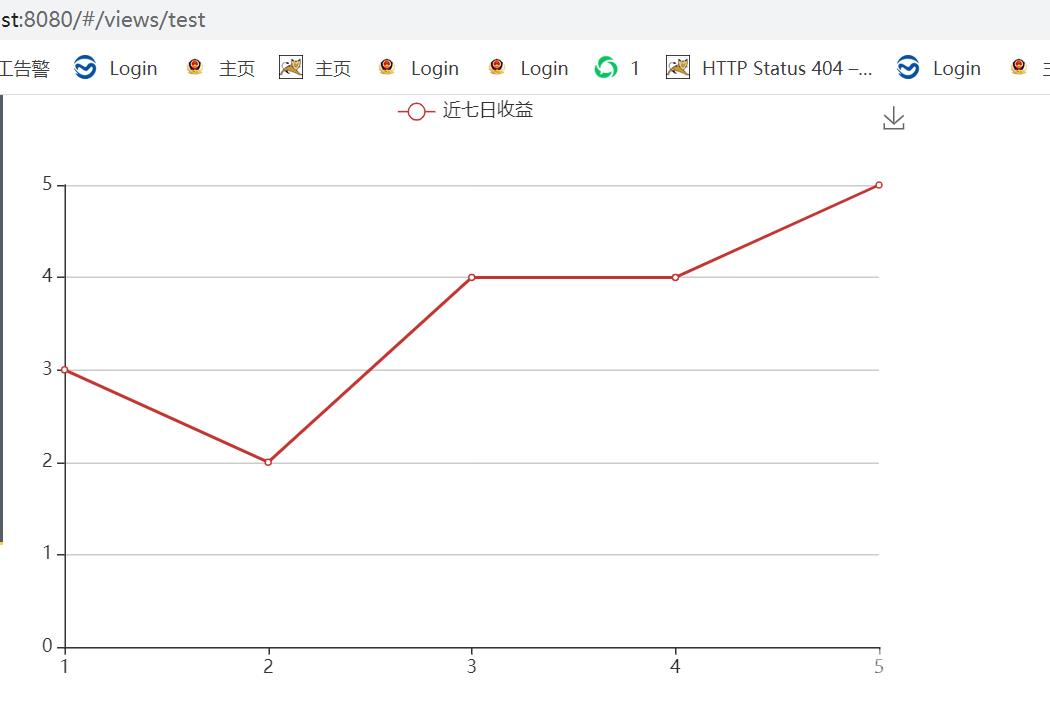
以上完成的,只是一个静态页面,下面就开始完成动态数据渲染部分的折线图部分啦~~
1:进入项目,npm安装
npm install axios --save

2:在main.js下引用axios
import axios from 'axios'
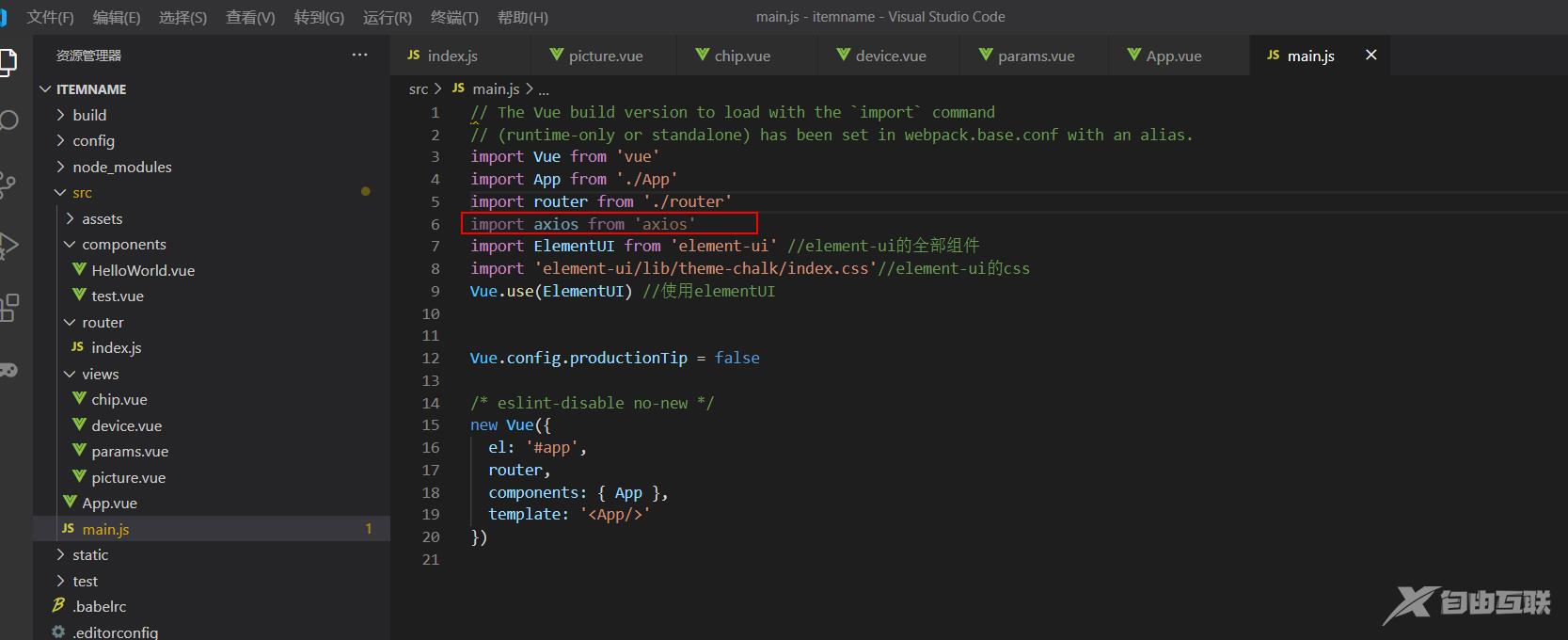
3:准备json数据
{
"categories": [
"1",
"2",
"3",
"4",
"5",
"6",
"7",
"8",
"9",
"10",
"11",
"12"
],
"data": [
3,
2,
4,
4,
5
]
}
4:跨域问题
一般后端小伙伴给到我们这边的接口里面,应该对跨域问题已经处理好了,所以不需要我们处理了。
如果需要我们处理,我们可以设置代理,利用proxyTable属性实现跨域请求
在config/index.js 里面找到proxyTable :{} ,然后在里面加入以下代码
(这里处于安全考虑,我隐藏了自己的而服务器域名,如果需要测试,改成你自己的即可)
proxyTable: {
'/api': {
target: 'http://inxxxe.com',//设置你调用的接口域名和端口号
changeOrigin: true,//允许跨域
pathRewrite: {
'^/api': '' //这个是定义要访问的路径,名字随便写
}
}
},
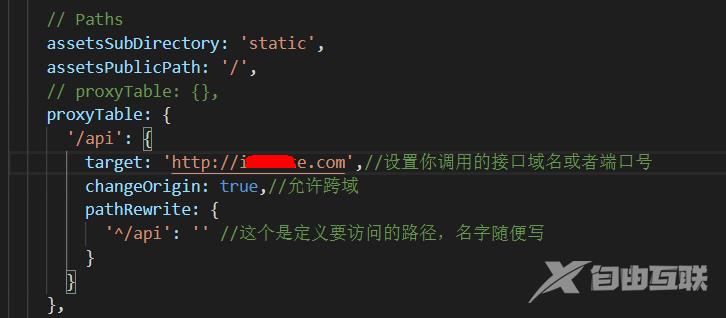
5:打开一个界面test.vue,开始写请求数据的方法
methods: {
getData() {
axios.get('/api/test.json').then(response => {
console.log(response.data);
this.opinionData =response.data.data;
this.drawLine('main')
}, response => {
console.log("error");
});
},
}
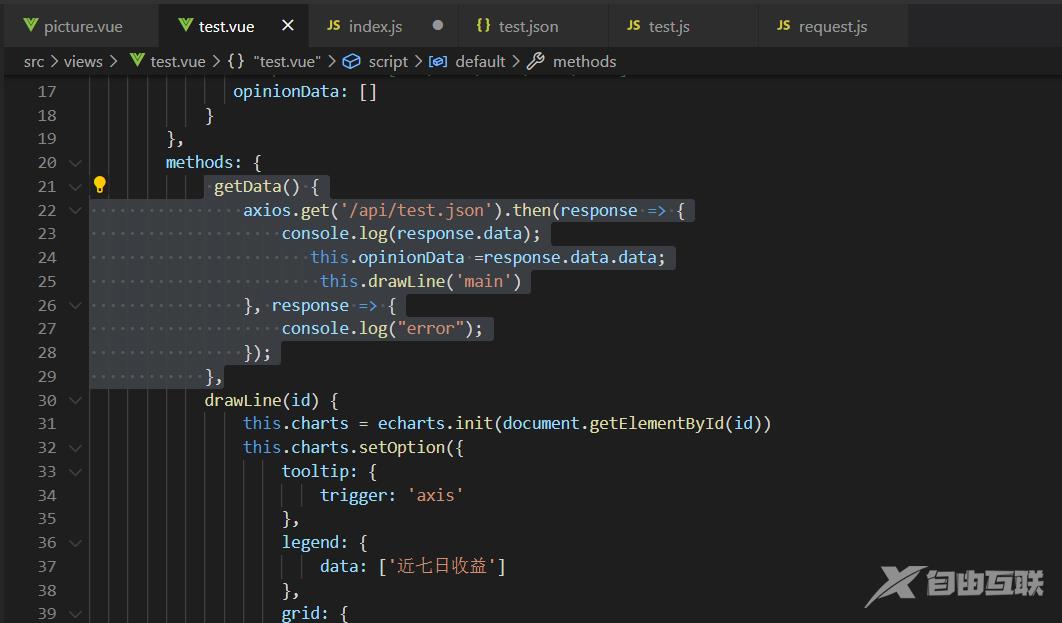
6:再次运行
npm run dev
运行成功之后,打开f12,查看network的请求
这个时候,我们可以看见,本地的localhost替代 了我之前放在服务器上的链接的域名,这也是设置代理成功,就解决了跨域的问题了。
请求成功
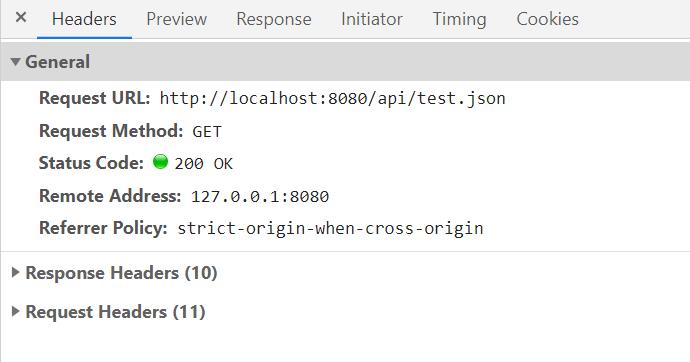
response里面也有返回值,ok,下一步就要开始将这些数据渲染在前端界面上面了。
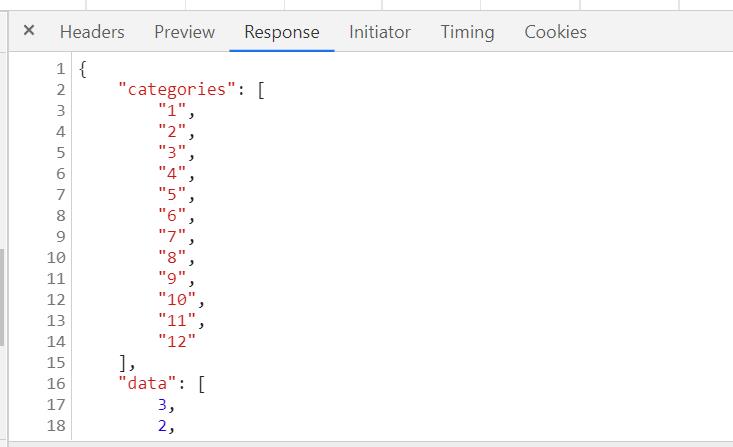
test.vue参考代码:
<template>
<div>
<!--为echarts准备一个具备大小的容器dom-->
<div id="main" style="width: 600px;height: 400px;"></div>
</div>
</template>
<script>
import echarts from 'echarts'
import axios from "axios";
export default {
name: '',
data() {
return {
charts: '',
/* opinionData: ["3", "2", "4", "4", "5"]*/
opinionData: []
}
},
methods: {
getData() {
axios.get('/api/test.json').then(response => {
console.log(response.data);
this.opinionData =response.data.data;
this.drawLine('main')
}, response => {
console.log("error");
});
},
drawLine(id) {
this.charts = echarts.init(document.getElementById(id))
this.charts.setOption({
tooltip: {
trigger: 'axis'
},
legend: {
data: ['近七日收益']
},
grid: {
left: '3%',
right: '4%',
bottom: '3%',
containLabel: true
},
toolbox: {
feature: {
saveAsImage: {}
}
},
xAxis: {
type: 'category',
boundaryGap: false,
data: ["1","2","3","4","5"]
},
yAxis: {
type: 'value'
},
series: [{
name: '近七日收益',
type: 'line',
stack: '总量',
data: this.opinionData
}]
})
},
},
//调用
mounted() {
this.getData();
}
}
</script>
实现效果
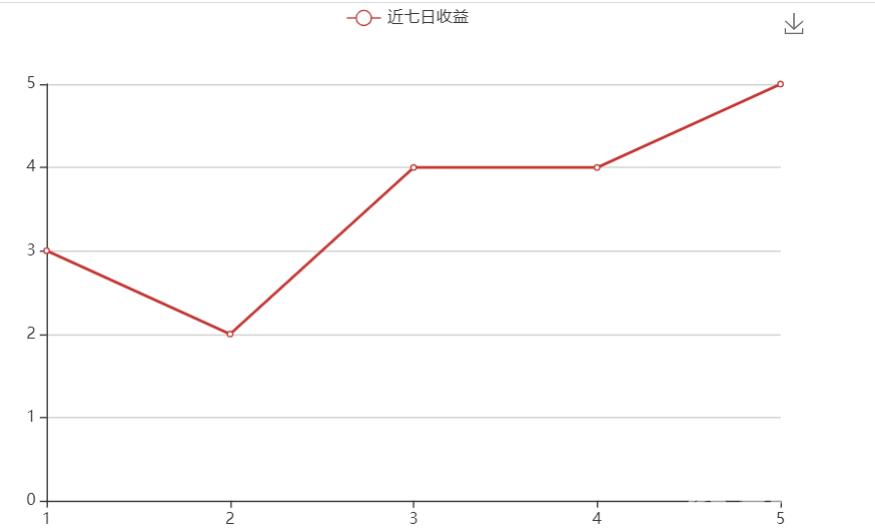
以上为个人经验,希望能给大家一个参考,也希望大家多多支持自由互联。
